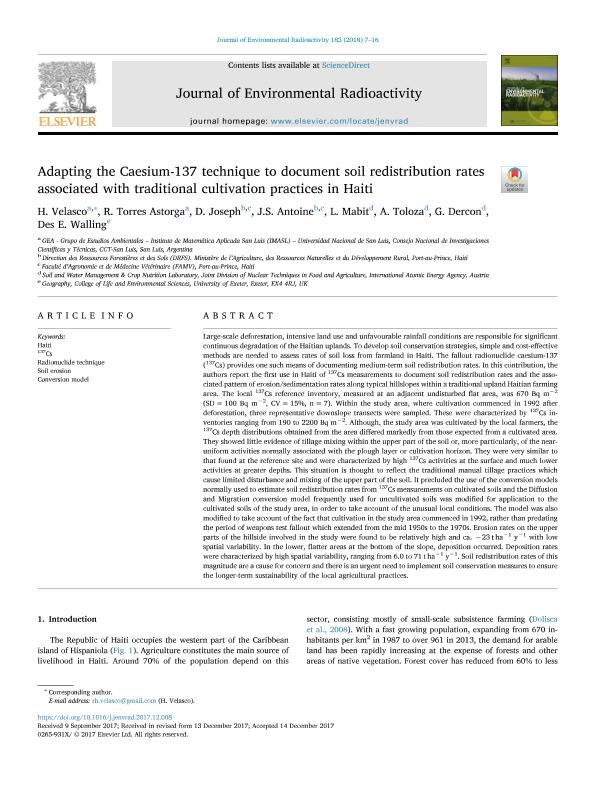Mostrar el registro sencillo del ítem
dc.contributor.author
Velasco, Ricardo Hugo

dc.contributor.author
Torres Astorga, Romina Vanesa

dc.contributor.author
Joseph, D.
dc.contributor.author
Antoine, J. S.
dc.contributor.author
Mabit, L.
dc.contributor.author
Toloza, A.
dc.contributor.author
Dercon, G.
dc.contributor.author
Walling, Des E.
dc.date.available
2019-12-30T15:35:28Z
dc.date.issued
2018-03
dc.identifier.citation
Velasco, Ricardo Hugo; Torres Astorga, Romina Vanesa; Joseph, D.; Antoine, J. S.; Mabit, L.; et al.; Adapting the Caesium-137 technique to document soil redistribution rates associated with traditional cultivation practices in Haiti; Elsevier; Journal of Environmental Radioactivity; 183; 3-2018; 7-16
dc.identifier.issn
0265-931X
dc.identifier.uri
http://hdl.handle.net/11336/93221
dc.description.abstract
Large-scale deforestation, intensive land use and unfavourable rainfall conditions are responsible for significant continuous degradation of the Haitian uplands. To develop soil conservation strategies, simple and cost-effective methods are needed to assess rates of soil loss from farmland in Haiti. The fallout radionuclide caesium-137 (137Cs) provides one such means of documenting medium-term soil redistribution rates. In this contribution, the authors report the first use in Haiti of 137Cs measurements to document soil redistribution rates and the associated pattern of erosion/sedimentation rates along typical hillslopes within a traditional upland Haitian farming area. The local 137Cs reference inventory, measured at an adjacent undisturbed flat area, was 670 Bq m−2 (SD = 100 Bq m−2, CV = 15%, n = 7). Within the study area, where cultivation commenced in 1992 after deforestation, three representative downslope transects were sampled. These were characterized by 137Cs inventories ranging from 190 to 2200 Bq m−2. Although, the study area was cultivated by the local farmers, the 137Cs depth distributions obtained from the area differed markedly from those expected from a cultivated area. They showed little evidence of tillage mixing within the upper part of the soil or, more particularly, of the near-uniform activities normally associated with the plough layer or cultivation horizon. They were very similar to that found at the reference site and were characterized by high 137Cs activities at the surface and much lower activities at greater depths. This situation is thought to reflect the traditional manual tillage practices which cause limited disturbance and mixing of the upper part of the soil. It precluded the use of the conversion models normally used to estimate soil redistribution rates from 137Cs measurements on cultivated soils and the Diffusion and Migration conversion model frequently used for uncultivated soils was modified for application to the cultivated soils of the study area, in order to take account of the unusual local conditions. The model was also modified to take account of the fact that cultivation in the study area commenced in 1992, rather than predating the period of weapons test fallout which extended from the mid 1950s to the 1970s. Erosion rates on the upper parts of the hillside involved in the study were found to be relatively high and ca. −23 t ha−1 y−1 with low spatial variability. In the lower, flatter areas at the bottom of the slope, deposition occurred. Deposition rates were characterized by high spatial variability, ranging from 6.0 to 71 t ha−1 y−1. Soil redistribution rates of this magnitude are a cause for concern and there is an urgent need to implement soil conservation measures to ensure the longer-term sustainability of the local agricultural practices.
dc.format
application/pdf
dc.language.iso
eng
dc.publisher
Elsevier

dc.rights
info:eu-repo/semantics/openAccess
dc.rights.uri
https://creativecommons.org/licenses/by-nc-nd/2.5/ar/
dc.subject
137CS
dc.subject
CONVERSION MODEL
dc.subject
HAITI
dc.subject
RADIONUCLIDE TECHNIQUE
dc.subject
SOIL EROSION
dc.subject.classification
Otras Ciencias de la Tierra y relacionadas con el Medio Ambiente

dc.subject.classification
Ciencias de la Tierra y relacionadas con el Medio Ambiente

dc.subject.classification
CIENCIAS NATURALES Y EXACTAS

dc.title
Adapting the Caesium-137 technique to document soil redistribution rates associated with traditional cultivation practices in Haiti
dc.type
info:eu-repo/semantics/article
dc.type
info:ar-repo/semantics/artículo
dc.type
info:eu-repo/semantics/publishedVersion
dc.date.updated
2019-10-24T18:16:40Z
dc.journal.volume
183
dc.journal.pagination
7-16
dc.journal.pais
Países Bajos

dc.journal.ciudad
Amsterdam
dc.description.fil
Fil: Velasco, Ricardo Hugo. Consejo Nacional de Investigaciones Científicas y Técnicas. Centro Científico Tecnológico Conicet - San Luis. Instituto de Matemática Aplicada de San Luis "Prof. Ezio Marchi". Universidad Nacional de San Luis. Facultad de Ciencias Físico, Matemáticas y Naturales. Instituto de Matemática Aplicada de San Luis "Prof. Ezio Marchi"; Argentina
dc.description.fil
Fil: Torres Astorga, Romina Vanesa. Consejo Nacional de Investigaciones Científicas y Técnicas. Centro Científico Tecnológico Conicet - San Luis. Instituto de Matemática Aplicada de San Luis "Prof. Ezio Marchi". Universidad Nacional de San Luis. Facultad de Ciencias Físico, Matemáticas y Naturales. Instituto de Matemática Aplicada de San Luis "Prof. Ezio Marchi"; Argentina
dc.description.fil
Fil: Joseph, D.. Faculté D'agronomie et de Médecine Vétérinaire; Haití. Ministère de L'agriculture; Haití
dc.description.fil
Fil: Antoine, J. S.. Faculté D'agronomie et de Médecine Vétérinaire; Haití. Ministère de L'agriculture; Haití
dc.description.fil
Fil: Mabit, L.. International Atomic Energy Agency; Austria
dc.description.fil
Fil: Toloza, A.. International Atomic Energy Agency; Austria
dc.description.fil
Fil: Dercon, G.. International Atomic Energy Agency; Austria
dc.description.fil
Fil: Walling, Des E.. University of Exeter; Reino Unido
dc.journal.title
Journal of Environmental Radioactivity

dc.relation.alternativeid
info:eu-repo/semantics/altIdentifier/doi/http://dx.doi.org/10.1016/j.jenvrad.2017.12.008
dc.relation.alternativeid
info:eu-repo/semantics/altIdentifier/url/https://www.sciencedirect.com/science/article/pii/S0265931X17307579
Archivos asociados
